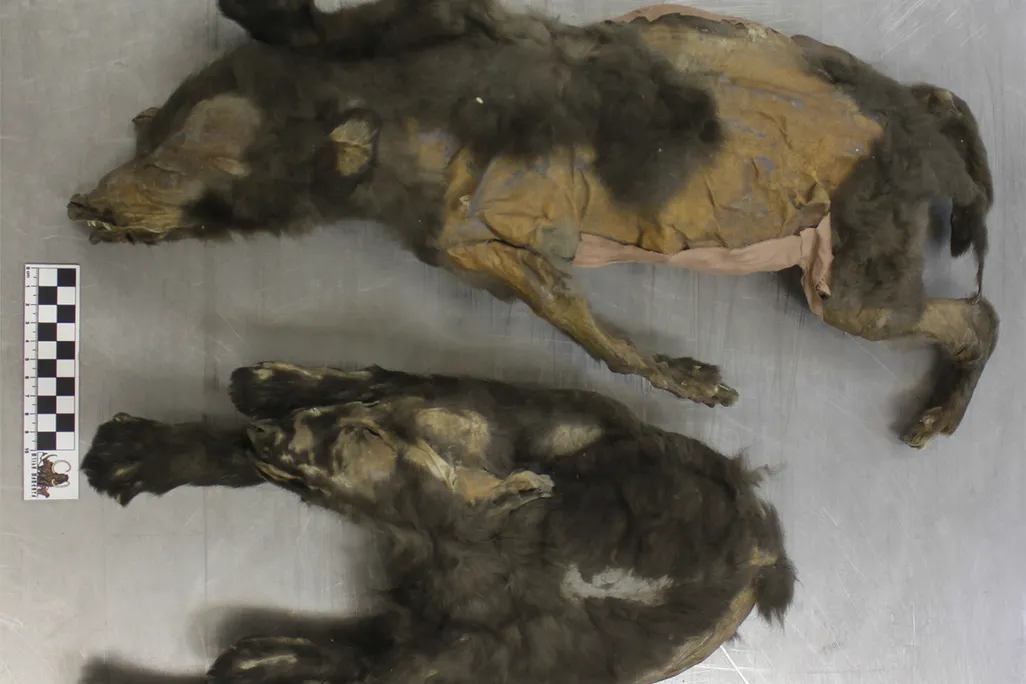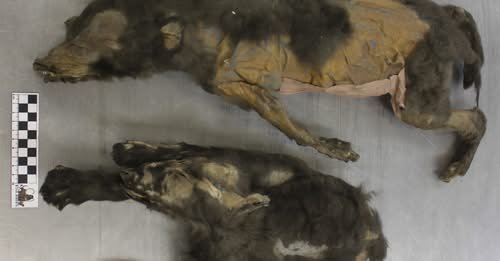14,000-Year-Old ‘Puppies’ Found in Siberia Were Wolf Littermates Who Dined on Woolly Rhino
Researchers studied chemicals found in the animals’ bones, teeth and tissues, as well as genetic material from their stomach contents

In 2011 and 2015, researchers unearthed a pair of remarkably well-preserved “puppies”—with their skin, fur and stomach contents still intact—from the permafrost in northern Siberia. Nearby, they also found butchered woolly mammoth bones, which made them curious about the canines’ relationship with humans. Were they docile wolves that hung around for food scraps, or possibly even early domesticated dogs?
Researchers still can’t fully answer these questions. But they have been able to learn a bit more about the mysterious canines’ diet and lifestyle, according to a new paper published in the journal Quaternary Research.
Earlier research found the naturally mummified puppies were likely wolves that belonged to a now-extinct population with no relation to domestic dogs, according to Live Science. The new paper expands on that earlier research by studying chemicals found in the animals’ bones, teeth and tissues, as well as genetic material from their stomach contents.
Their testing revealed the two cubs were sisters that were around two months old when they died roughly 14,000 years ago near the present-day settlement of Tumat, Siberia.
How exactly they died isn’t clear—their bodies showed no sign of injury—but the researchers suspect they may have been trapped inside their den. Perhaps they had just eaten a meal and were resting when a landslide collapsed their underground home, the researchers posit.
Since modern wolf litters are often larger than two pups, it’s possible that researchers might find additional cubs in the permafrost. Or, if the puppies did have siblings, perhaps those animals escaped the disaster altogether.
Testing also revealed they were omnivores that ate a mix of plants and animals—just like modern wolves. The cubs were eating solid food already, including a small bird called a wagtail and a woolly rhinoceros—probably a younger rhino brought down by adults in the pack. But the scientists also found evidence to suggest they were still nursing.
Their stomach contents contained the remnants of several plants, including reedgrass, arctic bluegrass and willow leaves. From this, the researchers gleaned that the puppies “lived along the banks of a river or an oxbow lake” and that “the climate at the time was dry and relatively mild,” says study co-author Mietje Germonpré, an archaeozoologist at the Institute of Natural Sciences in Belgium, in a statement.
Importantly, the researchers couldn’t find any evidence to suggest the cubs had eaten mammoth, so they could not establish a link between the canines and ancient humans. “Although the Tumat puppies inhabited a diverse landscape that was also occupied by humans, this study found no evidence that can conclusively link them to human activities,” the researchers write in the paper.
Dogs are the descendents of wolves, splitting off from a now-extinct wolf species some 15,000 to 40,000 years ago. But the timeline of their domestication by humans is a bit murky. One of the earliest known examples of a domesticated canine is the Bonn-Oberkassel dog, a puppy buried alongside a man and a woman roughly 14,000 years ago in present-day Germany.
The new findings don’t rule out the possibility that humans were supporting some canines during the Late Pleistocene in Siberia, possibly even the Tumat puppies. But, based on the existing evidence, the scientists just don’t have enough proof to tie the Tumat puppies to humans.
“When we’re talking about the origins of dogs, we’re talking about the very first domesticated animal,” says study co-author Nathan Wales, an archaeologist at the University of York, to CNN’s Ashley Strickland. “And for that reason, scientists have to have really solid evidence to make claims of early dogs.”
